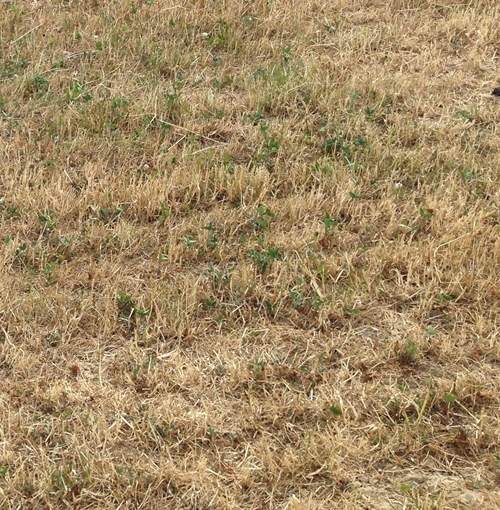We are experiencing an exceptional heatwave. Drought conditions are having severe impacts on arable crop yields and the forage available for livestock. Equally exceptional weather conditions in the spring forced livestock farmers to house their animals and feed silage much later than normal and hay and silage production has been severely limited by the dry conditions this summer. Hay is already being fed to some animals because of the lack of grass for grazing.

Drought-stressed grass and clover ley
With little rain in May, and none through the whole of June and July, our soil moisture data from fields at Loddington reveal why arable crops and grass alike are suffering. While soil moisture levels near the soil surface always decline through June and July, this year, soil moisture at depth has also declined earlier, more rapidly and to a greater extent than previously. These experiences are consistent with clmate change predictions made in the past, and with the current trend. As well as being severely affected by climate change, agriculture currently accounts for about 10% of UK greenhouse gas emissions, but because other sectors are decreasing their emissions, the agricultural contribution could rise to 30% by 2030. We need to understand these issues better at the farm and field scale.

Soil moisture at a series of depths in the soil profile in a wheat field at Loddington
The Allerton Project's research programme covers a very wide range of agri-environmental issues but I have been increasingly conscious of the need to improve our understanding of the impacts on and of climate change. In 2015, I was able to introduce the purchase of state of the art greenhouse gas monitoring equipment into a bid for the EU funded soil management research project, SoilCare and we subsequently became the only research farm within the network of sixteen across Europe to be gathering GHG data for the project. In achieving this, we have been very much aided by Falah Hamad who recently completed his PhD with us, gaining much valuable expertise in greenhouse gas monitoring in the process.

Falah Hamad gathering data from pasture for his PhD
In his PhD, Falah explored the relationship between soil physical properties and soil biology across a range of land uses. Amongst many other findings, he was able to demonstrate that carbon dioxide emissions are consistently higher from well structured biologically active soils than from compacted ground. Given that we are aiming for well structured soils to meet our many other objectives for crop production, catchment management and biodiversity conservation, we need to understand this relationship better, taking account of the wider context of inputs and field operations.
In the SoilCare project, our Soil Scientist, Felicity Crotty, takes this a stage further to investigate the emissions, not just of carbon dioxide, but of nitrous oxide, a gas with 298 times the global warming potential of carbon dioxide, and one that is often associated with compacted waterlogged soils. Although we expect emissions of methane to be low, we will also monitor this gas as it has a global warming potential that is 25 times that of carbon dioxide. We are exploring these greenhouse gas emissions in relation to a range of management practices that are designed to improve soil structure and function in arable and grass systems.
We have in mind objectives for improving crop and grass production, but also delivering public benefits such as improved water quality and reduced flood risk. Understanding greenhouse gas emissions will further enable us to explore the numerous trade-offs associated with land management practices that are adopted to address multiple issues such as these. As is all too clear at the moment, understanding how we continue to develop our food production while reducing our contribution to climate change must be high on the agenda.
We are now applying the experience we have gained through our recent research to other research projects at Loddington and are developing our existing collaborations with other research organisations. We will continue to encourage the active involvement of farmers and wider stakeholders in this process in order to understand the full practical and policy implications of our findings, and to guide future research.

Get the inside track on soil and water research
Priced at just £9.95, The Soil & Water Balance is a handy paperback which provides the inside track on soil and water research.
Presented in a Q&A style, much like last year’s popular Moorland Balance, this 100-page book looks at the problems and solutions on topics ranging from erosion and contamination, to the impact on songbirds and other wildlife.
Combining years of research at the GWCT's Allerton Project demonstration farm with tens of external scientific papers, this is a fascinating study of how farming can adapt to the challenges it currently faces.
Buy now >